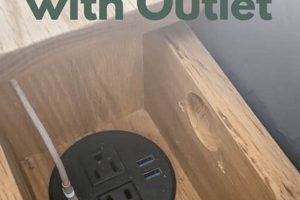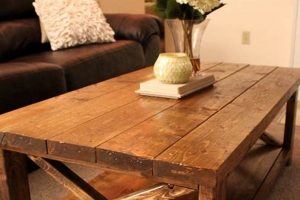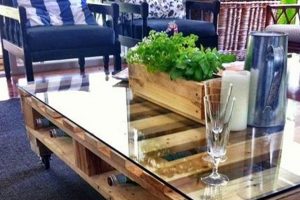A shop-made barrier designed to guide workpieces accurately across a router bit on a router table constitutes a vital component for woodworking. This device, typically constructed from wood or metal, provides a stable and adjustable surface against which material can be firmly held, facilitating precise cuts and consistent profiles. Examples include simple straight edges, fences with adjustable faces for jointing, and more complex models incorporating dust collection ports or featherboards for enhanced safety.
The use of a custom-built guide offers several advantages. It allows for tailored solutions to specific project needs, potentially saving costs compared to commercially available options. Furthermore, constructing one’s own guide fosters a deeper understanding of the router table’s operation and encourages innovation in jig design. Historically, woodworkers have relied on self-made jigs and fixtures to improve accuracy and efficiency, and this particular type of guide continues that tradition.
The subsequent discussion will delve into the materials and techniques commonly employed in its construction, exploring various design considerations and safety precautions necessary for successful implementation. This will cover essential elements, such as achieving squareness, ensuring adequate clamping pressure, and managing dust extraction for a cleaner and safer working environment.
Tips for Constructing a Shop-Made Router Table Guide
The fabrication of a functional and accurate router table guide demands careful attention to detail. The following tips offer guidance on key aspects of design, construction, and usage to maximize safety and performance.
Tip 1: Material Selection: Employ stable, dimensionally accurate materials like Baltic birch plywood or medium-density fiberboard (MDF) for the primary structure. Solid hardwoods can be used for wear surfaces or reinforcement, but ensure they are properly seasoned to minimize warping or movement.
Tip 2: Ensuring Squareness: Absolute squareness between the fence face and the table surface is paramount. Utilize precision measuring tools like a machinist’s square or a digital angle finder to verify alignment during assembly. Shimming or planing may be required to achieve perfect orthogonality.
Tip 3: Adjustable Faces: Incorporate adjustable faces if jointing or creating precise rabbets is anticipated. T-tracks and bolts, or threaded inserts and thumbscrews, provide a reliable mechanism for fine-tuning the offset of the outfeed fence relative to the infeed fence.
Tip 4: Dust Collection Integration: Effective dust collection is crucial for both safety and visibility. Include a dust port connected to a vacuum system. The port should be strategically positioned to capture debris generated by the router bit.
Tip 5: Robust Clamping Mechanism: A reliable clamping system ensures the guide remains securely in place during operation. Cam clamps, toggle clamps, or T-bolts with hand knobs can be used to affix the guide to the table, providing consistent clamping pressure without slippage.
Tip 6: Featherboard Compatibility: Integrate T-tracks or mounting points for featherboards. Featherboards exert pressure on the workpiece, keeping it firmly against the guide and table, significantly enhancing safety and cut quality.
Tip 7: Smooth, Low-Friction Surface: Apply a durable, low-friction coating, such as paste wax or PTFE tape, to the fence face. This reduces friction, allowing the workpiece to glide smoothly and consistently.
Tip 8: Miter Slot Compatibility: Consider adding a runner that fits into the router table’s miter slot. This adds additional stability and prevents movement of the guide during more demanding operations.
Adhering to these guidelines will contribute to a safer, more accurate, and more enjoyable woodworking experience. The resultant guide will prove to be a valuable asset in a variety of routing tasks.
The subsequent section will detail advanced design considerations and address common troubleshooting scenarios encountered when utilizing a shop-made router table guide.
1. Accurate material selection
The performance and longevity of a shop-made guide are inextricably linked to the selection of appropriate materials. The dimensional stability of the chosen material directly impacts the guide’s ability to maintain squareness and parallelism over time. For instance, utilizing untreated softwood for the primary fence structure is ill-advised, as changes in humidity can induce warping and twisting, ultimately compromising the accuracy of cuts. Conversely, materials like Baltic birch plywood or MDF exhibit superior resistance to dimensional changes, providing a stable platform for precise routing operations. This stability minimizes the need for frequent recalibration and ensures consistent results across multiple projects.
Consider a scenario where a woodworker constructs a guide using readily available construction-grade lumber. Despite initial efforts to achieve squareness, the lumber’s inherent tendency to warp leads to inaccuracies after a few weeks of use. Conversely, a guide constructed from MDF, while potentially less impact-resistant, maintains its shape and alignment, resulting in consistently accurate cuts. Furthermore, the surface characteristics of the material affect friction and ease of use. Smooth, non-porous surfaces like melamine-coated MDF facilitate smooth workpiece movement, while rough, unfinished surfaces can cause binding and inconsistent feeding rates. The choice of fasteners, such as screws or bolts, also falls under material selection. Using undersized or low-quality fasteners can lead to premature failure and compromise the structural integrity of the jig.
In summary, selecting appropriate materials is not merely a matter of convenience; it is a fundamental aspect of building a functional and reliable shop-made guide. The material’s dimensional stability, surface characteristics, and compatibility with fasteners directly influence the jig’s accuracy, durability, and overall performance. Diligent consideration of material properties is crucial for maximizing the effectiveness and lifespan of this essential woodworking accessory.
2. Precise perpendicularity
Establishing precise perpendicularity between the guide face and the router table surface is fundamental to achieving accurate and repeatable cuts. The accuracy of a shop-made router table guide is directly contingent upon maintaining a 90-degree relationship between these two planes. Deviations from this ideal introduce errors in workpiece dimensions and joinery, rendering the guide ineffective for precision woodworking tasks.
- Impact on Cut Accuracy
A guide that is not perfectly perpendicular to the table will produce angled cuts, even when the workpiece is held firmly against the fence. This is particularly problematic when routing dados, rabbets, or tenons, as the resulting joinery will be misaligned and structurally unsound. A deviation of even a fraction of a degree can accumulate over the length of a cut, leading to noticeable inaccuracies.
- Ensuring Squareness During Construction
Achieving precise perpendicularity requires meticulous attention to detail during the guide’s construction. The use of precision measuring tools, such as machinist’s squares or digital angle finders, is essential. Furthermore, the construction process must account for potential sources of error, such as inconsistencies in material thickness or inaccuracies in cutting techniques. Shimming or planing may be necessary to correct any deviations from squareness.
- Adjustability as a Correction Mechanism
In some designs, adjustability is incorporated to compensate for minor imperfections or wear over time. Adjustable faces, secured with T-tracks and bolts, allow for fine-tuning of the fence angle, ensuring that it remains perfectly perpendicular to the table surface. This feature is particularly valuable for guides used in demanding applications or those constructed from materials prone to slight movement.
- Consequences of Misalignment
The consequences of misalignment extend beyond dimensional inaccuracies. A guide that is not perpendicular to the table can also compromise safety. An angled guide can cause the workpiece to bind against the router bit, increasing the risk of kickback. Furthermore, a misaligned guide can introduce vibration and instability, making it more difficult to control the workpiece and achieve a clean, consistent cut. Therefore, ensuring precise perpendicularity is not merely a matter of achieving accuracy; it is also a critical safety consideration.
In conclusion, precise perpendicularity is an indispensable element in the design and construction of an effective shop-made router table guide. Its impact on cut accuracy, safety, and overall functionality cannot be overstated. Diligent attention to this aspect of construction will yield a guide that provides years of reliable service and enables the creation of high-quality woodworking projects.
3. Secure workpiece control
Secure workpiece control is paramount when utilizing any router table guide, particularly shop-made versions. This ensures operator safety, minimizes the risk of kickback, and promotes accurate, consistent cuts. A robust and well-designed guide, coupled with appropriate workholding techniques, forms the foundation for safe and effective routing operations.
- Featherboard Integration
Featherboards exert consistent pressure on the workpiece, holding it firmly against the guide and table surface. These devices mitigate the risk of the workpiece wandering or lifting during the routing process. A well-designed guide incorporates T-tracks or other mounting points to accommodate featherboards in various configurations. For example, a featherboard positioned before the router bit prevents side-to-side movement, while a featherboard placed after the bit keeps the workpiece from lifting.
- Hold-Down Mechanisms
Hold-down clamps or rollers apply downward pressure to the workpiece, preventing it from lifting or chattering. These mechanisms are particularly useful when routing thin or flexible materials. A router table guide can be designed to accommodate various hold-down devices, such as toggle clamps or commercially available hold-down systems. Consider a scenario where routing a thin sheet of plywood: without a hold-down, the plywood may vibrate and lift, resulting in an uneven cut. A hold-down eliminates this issue by maintaining constant downward pressure.
- Appropriate Hand Placement
Even with advanced workholding devices, proper hand placement is critical. Hands should be kept a safe distance from the router bit at all times. Push sticks and push blocks are essential tools for guiding the workpiece, particularly when making narrow cuts or routing small pieces. Never reach over or around the router bit while it is in operation. For instance, when routing a narrow groove, a push stick allows the operator to maintain control of the workpiece without placing their hands in close proximity to the cutting edge.
- Guide Adjustability
The guide’s adjustability plays a crucial role in maintaining secure workpiece control. A guide that can be easily adjusted to accommodate different workpiece thicknesses and routing depths ensures consistent contact between the workpiece and the guide face. A poorly adjusted guide may allow the workpiece to wobble or shift, compromising safety and accuracy. Consider a guide with adjustable faces: this allows the operator to fine-tune the guide’s position to perfectly match the workpiece thickness, ensuring stable and controlled routing.
In essence, secure workpiece control is not merely an added feature but an integral aspect of a well-designed shop-made guide. The incorporation of featherboards, hold-down mechanisms, and user awareness of hand safety, coupled with guide adjustability, contributes to a safer and more precise routing experience. The integration of these techniques, when combined with an accurate guide, leads to increased project quality and reduced risk of injury.
4. Efficient dust mitigation
Effective dust management is a critical consideration in woodworking, particularly when utilizing a router table. The creation of a shop-made guide presents an opportunity to integrate dust collection features directly into the design, enhancing both operator safety and the overall cleanliness of the workspace. Failure to adequately address dust generation can lead to respiratory problems, reduced visibility, and increased cleanup time.
- Enclosure Design
Enclosing the router bit as much as possible minimizes the escape of dust particles. The guide can be designed with side panels or a hood that partially or fully surrounds the bit, channeling airflow towards the dust collection port. An example involves creating a box-like structure around the bit, leaving only a small opening for the workpiece to pass through. This significantly reduces the amount of dust that escapes into the surrounding environment. The implication is a cleaner workspace and reduced exposure to harmful airborne particles.
- Dust Port Placement
Strategic placement of the dust port maximizes the capture of dust at its source. The port should be located as close to the router bit as possible, ideally below the cutting area to take advantage of gravity. One could incorporate a port directly behind the bit, capturing the majority of the dust as it is ejected. Effective placement ensures that the vacuum system efficiently removes dust before it disperses into the air, improving air quality and visibility.
- Airflow Optimization
Optimizing airflow within the guide enhances the effectiveness of dust collection. This can involve incorporating baffles or deflectors that direct airflow towards the dust port. For instance, angled surfaces can guide dust particles towards the vacuum source, preventing them from settling on horizontal surfaces. This ensures efficient dust removal, even with less powerful vacuum systems.
- Material Selection and Sealing
The materials used in guide construction and the quality of the seals affect dust containment. Smooth, non-porous materials like melamine or sealed MDF prevent dust from adhering to the guide’s surfaces. Sealing any gaps or cracks with caulk or weather stripping minimizes dust leakage. This approach creates a closed system, maximizing the efficiency of the dust collection system and minimizing airborne particles.
The integration of these dust mitigation strategies into the design of a shop-made router table guide is essential for maintaining a safe and healthy working environment. By addressing dust collection proactively, woodworkers can minimize their exposure to harmful particles, improve visibility, and reduce the time spent cleaning up. A thoughtfully designed guide incorporating efficient dust mitigation features becomes an invaluable asset in any woodworking shop.
5. Stable clamping pressure
Maintaining stable clamping pressure is crucial for the safe and accurate operation of a shop-made guide. Insufficient or inconsistent clamping pressure can lead to workpiece movement, resulting in inaccurate cuts, potential damage to the workpiece or router bit, and increased risk of injury. The design and implementation of an effective clamping system is therefore a primary consideration in guide construction.
- Clamping Mechanism Selection
The choice of clamping mechanism directly impacts the stability of the guide. Options include T-bolts with hand knobs, cam clamps, toggle clamps, and threaded inserts with screws. Each mechanism offers varying degrees of clamping force and ease of use. T-bolts provide adjustable clamping force but require more time to tighten. Cam clamps offer rapid clamping but may not provide sufficient force for all applications. Consideration of workpiece size, material, and routing forces is essential in selecting an appropriate clamping mechanism. An example is choosing cam clamps for quick adjustments during repetitive tasks versus T-bolts for maximum holding power when routing dense hardwoods.
- Clamping Surface Area
The surface area of the clamping interface influences the distribution of clamping pressure. A larger clamping surface area distributes force more evenly, reducing the likelihood of localized pressure points that can damage the guide or workpiece. Incorporating wide clamping pads or backing plates increases the effective clamping surface area, enhancing stability. Consider using a metal backing plate behind a wooden clamping pad to prevent deformation and maintain consistent pressure over time. A larger surface area minimizes stress concentrations, resulting in a more secure and reliable hold.
- Material Compatibility
The materials used for the clamping components must be compatible with both the guide material and the workpiece material. Using excessively hard clamping pads on soft wood can cause indentation and reduce clamping effectiveness. Conversely, using soft clamping pads on hard materials may result in slippage. Selecting materials with appropriate friction coefficients and hardness values is crucial for achieving optimal clamping performance. For example, using neoprene or rubber clamping pads on delicate materials provides a secure grip without causing damage. Ensuring material compatibility prevents slippage, damage, and inconsistent clamping pressure.
- Adjustability and Repeatability
The ability to easily adjust and repeat the clamping pressure is essential for consistent results. A well-designed clamping system allows for fine-tuning of the clamping force to accommodate varying workpiece thicknesses and material densities. Graduated scales or detents can be incorporated to provide repeatable clamping pressure settings. This feature ensures that the same clamping force is applied consistently across multiple workpieces, minimizing variations in cut quality. Implementing a simple indexing system allows the user to quickly and accurately adjust the clamping pressure to the desired level, ensuring consistent and reliable results.
These considerations, when integrated into the design and construction of a shop-made guide, contribute to a clamping system that provides stable, reliable, and repeatable clamping pressure. This, in turn, enhances safety, improves accuracy, and ensures consistent results in a wide range of routing operations, allowing the creation of high-quality woodworking projects.
Frequently Asked Questions
This section addresses common inquiries regarding the design, construction, and utilization of shop-made router table guides, providing concise and informative answers based on established woodworking practices.
Question 1: What are the primary advantages of constructing a shop-made router table guide versus purchasing a commercially available model?
Construction of a custom guide enables tailored solutions specific to individual project needs and shop configurations. It promotes a deeper understanding of router table operation and facilitates cost savings relative to commercial alternatives. The ability to customize dimensions, features, and material choices represents a significant advantage.
Question 2: What materials are most suitable for building a durable and accurate shop-made guide?
Dimensionally stable materials such as Baltic birch plywood, medium-density fiberboard (MDF), and seasoned hardwoods are recommended. These materials resist warping and maintain squareness over time. The selection of fasteners, such as screws or bolts, should also be considered to ensure structural integrity.
Question 3: How is precise perpendicularity between the guide face and the table surface best achieved and maintained?
Precise perpendicularity is achieved through meticulous measurement during construction using tools such as machinist’s squares or digital angle finders. Shimming or planing may be required to correct deviations. Incorporating adjustable faces allows for fine-tuning and compensation for wear or material movement over time.
Question 4: What are the key considerations for ensuring secure workpiece control during routing operations?
Secure workpiece control is facilitated through the integration of featherboards and hold-down mechanisms. Featherboards exert consistent pressure against the guide, while hold-downs prevent lifting or chattering. Push sticks and push blocks should always be used to maintain a safe distance between hands and the router bit.
Question 5: How can efficient dust collection be effectively integrated into a shop-made router table guide?
Efficient dust collection is achieved through strategic dust port placement, optimized airflow, and enclosure design. The port should be located as close to the router bit as possible, and the guide should be designed to minimize the escape of dust particles. Smooth, non-porous materials and sealed gaps enhance containment.
Question 6: What are the most common troubleshooting scenarios encountered when using a shop-made router table guide, and how can they be addressed?
Common issues include guide slippage, inaccurate cuts due to misalignment, and insufficient dust collection. Slippage can be addressed through the use of appropriate clamping mechanisms and friction-enhancing materials. Misalignment requires recalibration and adjustment. Insufficient dust collection may necessitate adjustments to port placement or airflow optimization.
The design and construction of a successful shop-made router table guide require careful attention to detail, material selection, and safety considerations. By addressing the points covered, woodworkers can create a valuable and reliable tool.
The subsequent section will present real-world examples and case studies of shop-made guides.
Concluding Remarks on Shop-Made Router Table Guides
This exploration of the “diy router table fence” underscores its critical role in precision woodworking. Accurate material selection, perpendicularity, secure workpiece control, effective dust mitigation, and stable clamping pressure constitute essential elements for its successful implementation. The discussion has emphasized the practical benefits, construction techniques, and crucial safety considerations that underpin the design and utilization of such a fixture.
The information presented intends to empower woodworkers to construct reliable and cost-effective solutions tailored to their specific needs. As woodworking practices evolve, continued attention to these core principles will ensure the continued relevance and utility of shop-made router table guides. Further experimentation and refinement are encouraged to optimize performance and address emerging challenges in the field.







